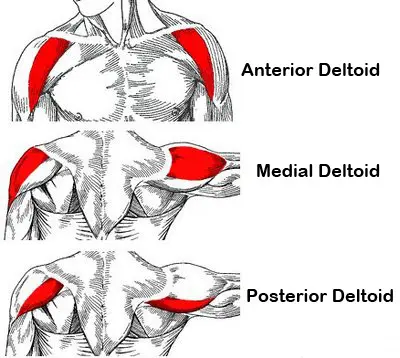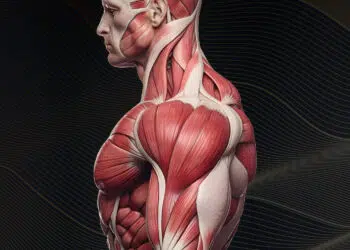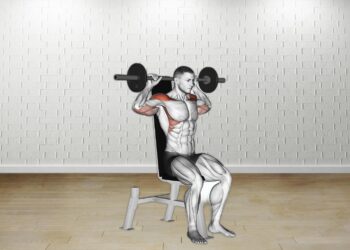The deltoid muscles are among the most-used muscles in your body.
Think about it: every time you move your arms, your shoulder muscles have to work. Every time you push or pull something heavy, your deltoids engage along with your chest, upper back, biceps, triceps, and forearms to get the job done.
They may not be the largest of your upper body muscle groups, but they’re certainly one of the most called-upon. Knowing that, it’s imperative that you train your deltoid muscles adequately to increase your upper body strength and power.
In this article, we’re going to focus on cable machine exercises. While there are dozens of amazing deltoid exercises you can do using free weights (kettlebells, dumbbells, barbells, etc.), we like cable machines because:
- They lead to better muscle engagement and isolation.
There’s less demand on secondary stabilizer muscles, and the isolation of cable machine exercises places greater demand on the primary movers—in this case, the deltoid muscles. - They increase time under tension.
The more time muscles spend under tension, the greater the workload, which can lead to faster hypertrophy and better gains over the long term. - They are easy and safe even for beginners. Cable machines can be very forgiving for those just learning to master the correct form, making it easier to focus on smooth movement to safely improve form.
Go through the list of deltoid exercises below, find the ones you like best, and add them to your weekly shoulder workout routine. You’ll find you can develop serious power and better muscle definition thanks to these amazing cable machine exercises.
Before You Start: Understanding Deltoid Muscle Anatomy

Level Up Your Fitness: Join our 💪 strong community in Fitness Volt Newsletter. Get daily inspiration, expert-backed workouts, nutrition tips, the latest in strength sports, and the support you need to reach your goals. Subscribe for free!
In order to effectively work out the deltoid muscles, you need to understand how this muscle—in a way, almost like its own small muscle group—is structured.
The deltoids consist of three muscle heads:
- The posterior deltoid enables lateral rotation, moving the arm backward and outward. It’s the muscle that enables you to reach behind your back, and it engages when you throw something.
- The lateral deltoid enables lateral movement, focused primarily on moving the arm outward (away from your body). It actually moves your shoulder joint downward to allow your arm to smoothly lift up away from your body.
- The anterior deltoid enables forward and inward movement of the arm, rotating your shoulder joint medially (toward the center of your body) to facilitate forward flexion. It’s the muscle head most commonly used during your everyday activities, literally every time your arm moves forward to shake hands, write, reach, etc.
It’s common to develop a larger, more powerful anterior deltoid through not only everyday activities, but also through workouts such as Bench Presses and Push-Ups. Deltoid imbalances—with greater development of the anterior deltoid—can lead to poor posture, causing you to “hunch” forward. For this reason, it’s critical to focus on training the posterior and lateral deltoids to even out the muscle definition and build broad, strong shoulders.
The 7 Best Deltoid Cable Machine Exercises
Here are our top recommended cable machine exercises you can do to sculpt seriously powerful deltoid muscles:
Cable Shoulder Press
The Shoulder Press is often considered the “bread and butter” of shoulder workouts. It’s a highly balanced movement that engages all three muscle heads effectively, and works on a single plane of motion to prevent shoulder joint strain.
Cable machines maintain the weight on your shoulders between reps, increasing the time under tension throughout the entire range of movement. It’s one of the most effective muscle-building exercises you can use to develop powerful showers.
To perform the exercise:
- Stand with your back to the cable machine, gripping the handles comfortably just above shoulder height with your palms facing forward. Keep your knees bent and your spine and neck straight throughout this entire exercise. Your shoulders and arms should be the only muscles doing the work.
- Push the handles up until your arms are extended. Twist your hands in toward each other as you approach the peak of the exercise—this will lead to fuller deltoid muscle engagement.
- Hold at the peak for a 1-count. Forcing the muscles to maintain a static position between movements can increase time under tension and accelerate growth.
- Lower the handles slowly back to the starting position, controlling the descent.
- Repeat as desired.
See the form here:
Read more about cable shoulder press.
A few sets of Cable Shoulder Presses will fire up those delts and bring the pain!
Bonus: Single-Arm Shoulder Press – If you want to maximize core engagement while performing this exercise, grip just one handle at a time. The unilateral (one-sided) movement will force your abs, obliques, and lower back muscles to work to keep you stable and upright.
Level Up Your Fitness: Join our 💪 strong community in Fitness Volt Newsletter. Get daily inspiration, expert-backed workouts, nutrition tips, the latest in strength sports, and the support you need to reach your goals. Subscribe for free!
Face Pull
This exercise increases the focus on the posterior deltoids, but still requires the lateral and anterior deltoids to work in concert for maximum pulling power. It’s an excellent movement to help you strengthen and expand the muscles on the back of your shoulders to maintain proper balance and prevent a forward hunch.
To perform this exercise:
- Stand facing the cable machine, with your knees slightly bent and your back and head straight.
- Set the pulley height to the level of your face, extend your arms fully, and grip each side of the rope handle firmly in both hands.
- Step back until there is tension on the cable when you fully extend your arms in front of you.
- Pull the handles toward your upper face, aiming for your forehead. Your elbows should naturally bend downward as you pull.
- As your hands near your forehead, shift them slightly outward and twist your wrists so your palms come to roughly the level of your ears. You’ll feel the contraction in both your posterior deltoids and upper back muscles.
- Hold for a 1-count at the peak of the movement to increase time under tension.
- Slowly return your hands to the starting position, controlling your movements.
- Repeat as desired.
See the form here:
This “Pull” exercise will do wonders to help you build the strength you need for Pull-Ups and Rows, and will maintain a healthy balance of muscular development between your posterior and anterior deltoids.
Read more about face pull.
Cable Front Raise
This is a classic exercise typically performed using dumbbells, but it can be even more effective when performed with the cable machine. You can focus more on controlling the movement and totally eliminating the “swing” common with free weights. It targets the anterior deltoid chiefly, but can help to develop lateral power, too.
To perform this exercise:
- Set the cable machine at its lowest point (just above the floor), and secure the standard D-handle.
- Grip the handle firmly in your right hand, and stand with your back to the machine.
- Raise the handle straight out in front of you to roughly shoulder height.
- Control your descent as you return to the starting position, handle by your side.
- Repeat as desired, then switch to your left hand.
See the form here:
Front Raises are one of the best movements to help you target the anterior deltoids that are engaged when you push or raise your arm in front of you. Using the cable just makes it more effective!
Cable Lateral Raise
This side-raising exercise will target the lateral deltoids, which are needed to pull your arms outward to the side. The lateral deltoids don’t typically get as much attention as the anterior and posterior deltoids, but they’re important for both pushing and pulling movements, as well as filling out the “broad-shouldered” look. If you want better definition, you need to pay more attention to your lateral delts.
To perform this exercise:
- Set the cable machine at its lowest point (just above the floor), and secure the standard D-handle.
- Grip the handle firmly in your right hand, and stand with your left side turned toward the machine.
- Raise the handle straight out to the right, with the cable crossing your body. Keep raising until you reach slightly above shoulder height.
- Control your descent as you return to the starting position, handle in front of your body.
- Repeat as desired, then switch to your left hand.
See the form here:
This unilateral exercise will also engage your abs, obliques, and spinal muscles to keep you steady and stable as you work, making it a highly effective way to build core strength while training your upper body.
Standing Cable Rear Delt Fly Crossover
The name may be a mouthful, but the exercise is both incredibly simple and incredibly effective for building posterior deltoid strength. Plus, your upper back and traps will join in the effort, helping you to develop that raw power you need for all your “Pull” exercises.
To perform this exercise:
- Set the cables to the highest adjusted setting (at the top of the machine), and secure the standard D-handle.
- Stand in the middle of the two cable machines, and reach out to grip the opposite handles—right hand gripping handle on the left side, left hand gripping the handle on your right side.
- Straighten your back and engage your spine to keep your upper body unmoving. Your arms should be the only thing in motion during this exercise.
- Pull out, back, and down to pull the handles across your chest, until your arms are fully extended at roughly the level of your nipples.
- Hold for a 1-count, squeezing your back and shoulder muscles to maximize tension.
- Slowly return to the starting position.
- Repeat as desired.
See the form here:
This fly-crossover movement will do wonders to target the lesser-used posterior deltoid and build strength in concert with your upper back muscles.
Rotator Cuff Internal Rotation
The rotator cuff is one of the supporting muscles that enable your shoulder to move smoothly. Unfortunately, it’s also the muscle most likely to be damaged by incorrect movement (often as a result of insufficient shoulder strength). Training the rotator cuff is an excellent way to minimize shoulder injuries and maximize strength.
This exercise will focus on this crucial muscle, together with your lateral deltoids. It absolutely deserves a place in EVERY shoulder workout you do.
To perform this exercise:
- Set the cable to just above waist height, using the D-handle attachment.
- Stand with your left side facing the machine, and grip the handle in your right hand.
- Set up your posture so your elbow is bent comfortably, your wrist is facing inward, and your spine is straight. (If it helps, you can place a rolled-up towel between your elbow and side to encourage better isolation.)
- Using only your shoulder muscles, rotate your arm outward at the elbow, moving the cable from the 3 o’clock position to the 9 o’clock position. Don’t worry if you don’t have a full range of motion—just rotate to the angle that feels natural for you.
- Maintaining a static elbow and upper arm, rotate inward to return to the starting position.
- Repeat as desired, then switch to your left hand.
See the form here:
This exercise will help to strengthen your rotator cuff and drastically reduce future shoulder injuries.
Read more about Deltoid:
- Best Side Delt Exercises for Broader, Powerful Shoulders
- A Head by Head Guide to Deltoid Training
- Cable Lateral Raise Exercise Guide
- Comprehensive Guide For Building Cannonball Deltoids
- Bigger Shoulders In Less Than 30 Minutes-Session
- At-Home Shoulder Exercises For Big Gains
- Best Rear Delt Exercises For Mass
Conclusion:
Working your shoulder muscles is absolutely crucial—not only to develop greater strength for all the upper body exercises you’ll do, but also to maintain a healthy muscular balance and bulletproof your shoulders from injury.
Strong shoulders make your arms, chest, and back stronger, enabling you to get through your workouts and daily activities of life more effectively. Add these deltoid-focused cable machine exercises into your weekly routines, and you’re guaranteed to see results in your power and muscle definition.








